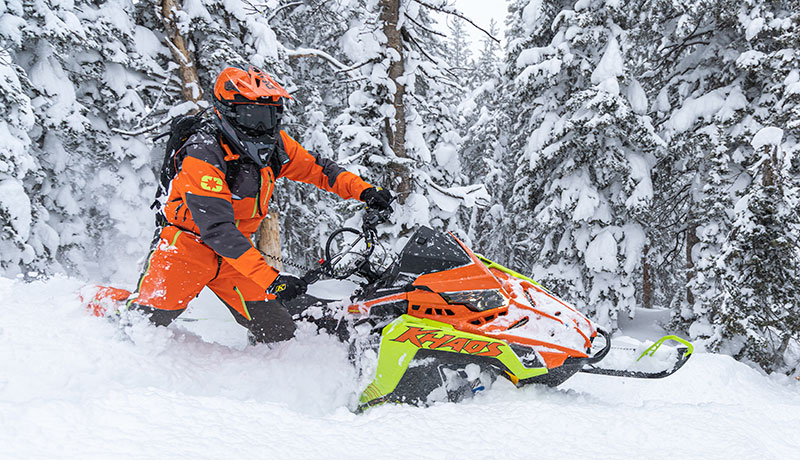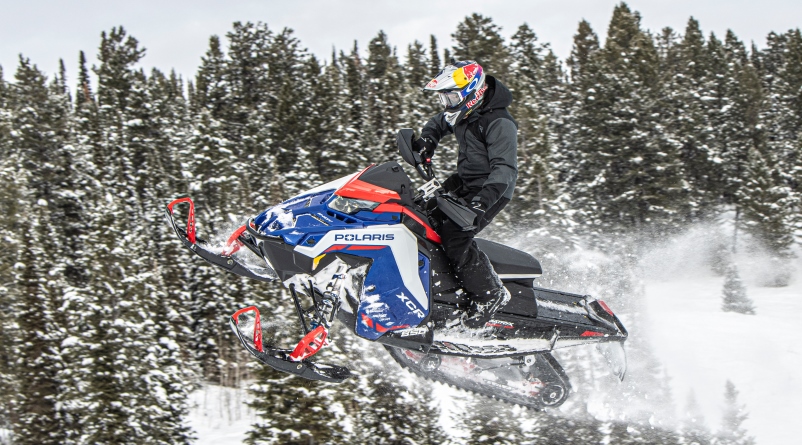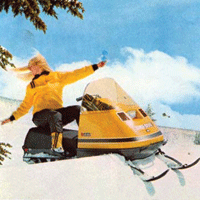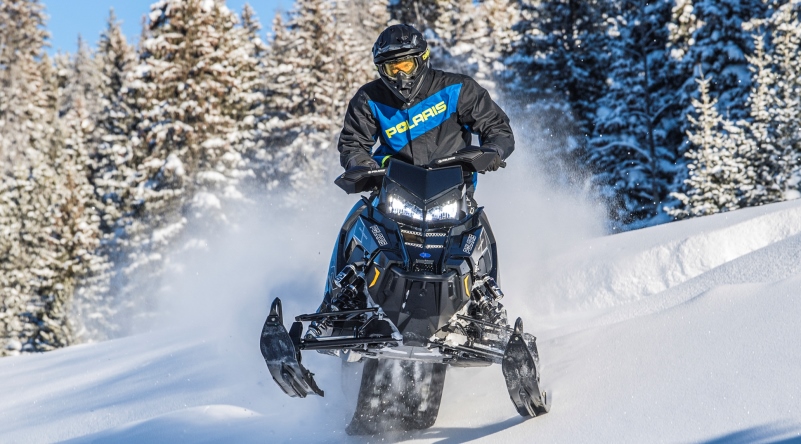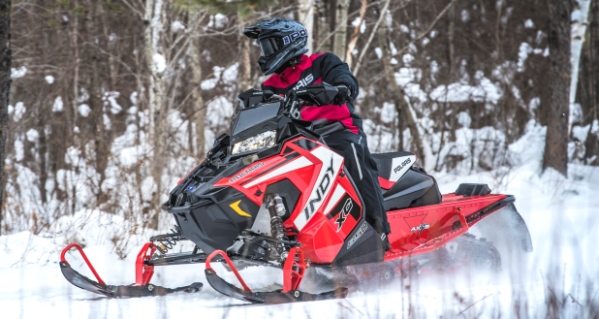 What do you get when you take the two most modern, lightweight chassis in the snowmobile industry, set them up with features for long-range cruising (mid-height windshield, electric start, reverse, storage, less-aggressive suspension settings, etc.) and give them a classy paint job? Is it:
What do you get when you take the two most modern, lightweight chassis in the snowmobile industry, set them up with features for long-range cruising (mid-height windshield, electric start, reverse, storage, less-aggressive suspension settings, etc.) and give them a classy paint job? Is it:
A) Two snowmobiles that are perfect for a broad cross-section of trail riders
B) Two snowmobiles with ride-all-day comfort
C) Two snowmobiles that get labeled as “geezer sleds” and are generally ignored by the masses
D) All of the above.
The answer is D – all of the above.
Ski-Doo officials in particular have lamented the fact that the company has worked hard to build its GSX brand into the equivalent of a BMW motorcycle or Lexus. The GSX E-TEC 600 H.O. LE is comfortable, well mannered and capable of being ridden at controlled, touring speeds in style or wrung out hard on a particularly interesting section of trail. Yet, the machine just doesn’t sell well. One Ski-Doo official admitted that that GSX brand is being given one last chance – if it doesn’t sell well this year, it’s done.

As if chasing Ski-Doo’s lack of success with the GSX line, Polaris for 2011 introduced the 600 Rush LX. Like the GSX, it features all of the solo touring features a rider could want, and it shares a chassis with Polaris’ top-flight Rush snowmobiles, just like the GSX is found in the same base chassis as the popular MX Z line. Polaris has been down this road before with its Indy Classic line, producing very good snowmobiles that are perfect for most riders, but similarly ignored by most riders. The fear for Polaris has to be that its new LX line gets strapped with the image of being a “geezer sled” or a “chick sled” by far too many people, like the GSX or Classics of the past.
Stepping beyond these stereotypes and labels, we found two snowmobiles that are quick, fun, comfortable and controllable – what more could your average trail rider want? The only question is whether buyers will let their ego get in the way of them getting the snowmobile that truly fits them and their riding style.
2011 Polaris 600 Rush LX: $10,599
A year ago we criticized Polaris for its 600 IQ LX that seemed more like an amalgamation of older parts than a specifically designed luxury touring machine. For 2011, the Roseau, Minnesota-based company flipped that criticism on its ear by producing the new, cutting-edge 600 Rush LX.
It’s based on the Pro-Ride chassis introduced on last year’s 600 Rush — our 2010 Snowmobile of the Year. The most visual year-over-year change for the LX is the bizarre-looking rear end, featuring the exposed rear suspension with an outboard shock and short tunnel. Hidden beneath the angular bodywork is a rigid, modern, lightweight chassis held together in part with structural bonding. Power is provided by the familiar 599cc Cleanfire-injected, liquid-cooled twin that produces horsepower in the mid-120s.
On our test ride, the 600 Rush LX proved to be a wonderful solo touring machine, with decent power, top-notch handling and a solid, quality feel.
Some solo touring riders may feel cramped on the rather short seat, but the LX is actually pretty easy to control from the rear of the seat, whereas most Rush performance models handle best when the rider is hugging the gas tank.
That said, the LX definitely corners best when the rider is taking more aggressive leans into turns. The dual A-arm front suspension tracked well but could lift a ski in corners if the rider got lazy and didn’t shift his body weight. We worked with the rear suspension settings and found the machine to generally be comfortable with the Fox IFP shocks front and back, yet it did provide plenty of feedback through the chop – not a harshness per se, but more of a jiggle or shake.
Even with more aggressive settings, the Walker Evans-based setup on the Rush Pro-R models provide a smoother ride.
The front window did an adequate job of blocking breezes to the upper torso, but a lot of cold air is forced over the driver’s legs. We appreciated the hooked handlebars that are wider and sit taller than on the IQ LX model. Quality features include standard bags that hang off the back of the seat and provide 1,450 cubic inches of storage, hood-mounted mirrors, a 12-volt outlet on the dash and a plug for heated helmet shields on the steering column.
Compared directly to the GSX, the Rush gets high points for cool styling and stable handling, while losing some points for comfort in stutter bumps and difficulty in adjusting the rear spring.
2011 Ski-Doo GSX E-TEC 600 H.O. LE: $10,549

While Polaris opted for “classic” silver and black, with touches of red, for the bodywork on its Rush LX, Ski-Doo designers seemed to take a decided step in the other direction for 2011, giving more of an MX Z look to the GSX.
The move made sense after Ski-Doo officials said that many folks will start with an MX Z and add their own high-quality touring features rather than buy a GSX and have their friends see that as a sign that they are old and slow.
The GSX E-TEC 600 H.O. LE is housed in Ski-Doo’s now familiar REV-XP platform it shares with MX Zs. The chassis is light, has a quality feel and is roomy, particularly when compared to the original REV chassis that didn’t allow the rider to get his or her feet in front of them. The seat is soft and comfortable, the handlebars are well positioned.
The SC-5 rear suspension offers a variable-rate HPG shock on the rear arm, while the dual A-arm front has standard HPG coil-overs. They provide adequate bump absorption and good stability. The machine has an overall feeling of being well-balanced, and the steering is ultra-light — no immediate need for power steering here.
The handling, though, is more nervous than the Polaris, sometimes requiring a mid-corner correction or counter steer. Most owners get used to this handling quirk, but it is made more prominent when riding the machine back-to-back with the more stable Polaris.
The direct-injected 594cc liquid-cooled twin provides good trail power, but whines more at mid to high RPM — to the ear, the Polaris powerplant sounds performance-oriented while the Rotax lets loose a less pleasing sound.
Noise aside, however, the engine’s incredible fuel and oil mileage and record of durability dispel any innuendos about its build quality — we’ve put several thousand miles on E-TEC 600s, have never had a mechanical problem and the engine always get the best mileage in our riding group. In the words of one test rider, “It runs like an expensive watch.”
High-end, multi-function gauges, saddlebags that are truly integrated into the sled’s design, high windshield-mounted mirrors and 12-volt and heated shield outlets further the high-quality touring feel of the machine. Bonus points are offered to Ski-Doo for the little kickers on top of the body panels that keep wind off the driver’s legs.
Compared to the Rush LX, the GSX gains extra points for roominess, engine efficiency and bump absorbing, while it falls behind the Polaris in terms of handling and upper-body wind protection.

